FATE™ (Facility Flow, Aerosol, Thermal, and Explosion) is a flexible, fast-running code developed and maintained by Fauske and Associates under an ASME NQA-1 compliant QA program. It is a specialized tool that is commercially available, but it is primarily used to support our related safety consulting services. FATE has advanced capabilities to model heat and mass transfer, fluid behavior, and aerosol behavior in a variety of applications for the nuclear, chemical, and manufacturing sectors. FATE aerosol and transport models are universal and not restricted to nuclear or chemical release. This article reviews FATE capabilities. For more information on applications visit https://www.fauske.com/consulting/fate-facility-modeling
Introduction
Flammability and explosion hazards can exist in many types of facilities, and many different variables can affect the progression of these types of events. If such events might release toxic material, it becomes even more critical to fully understand the influence of structures, systems and emergency response procedures.
Prevention of flammability and explosion hazards and minimization of toxic release can be achieved by properly designing ventilation and monitoring systems. A practical fast-running tool such as FATE is ideal for refining the distribution of flammable gas (or dust) and quantifying any unintended release from a process facility. Such a refined analysis becomes more important for highly compartmentalized structures where localized accumulation can occur, such as those shown in Figures 1 and 2. For example, industrial natural gas explosions are not uncommon, usually because purge and ventilation procedures are not adequate. Hydrogen explosion risks to the plant and personnel are clearly illustrated by analysis of the Fukushima accident and are relevant to upsets in chemical processing, smelters, and energy storage facilities. Transport and accumulation of virus-bearing aerosol is another example where mechanistic models can guide decision making.
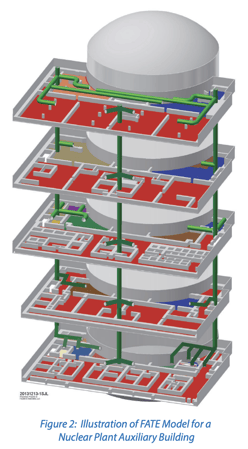 FATE is a specialized computer code that has seen extensive use in supporting hazardous waste treatment activities and is developed and maintained by Fauske & Associates under our NQA-1 compliant quality program. Containers, buildings and processes are modeled using nodes, junctions and heat sinks to track flammable gas release, stratification and distribution, along with heat transfer and aerosol transport. Model options include plume entrainment, deflagration of gas or dust, condensation and aerosol formation. FATE is convenient for fire accident modeling because it tracks density driven flow of stratified and potentially “smoky” layers. Such models are of general utility for any facility where the evolving distribution of gas/aerosol is of potential concern.
FATE is a specialized computer code that has seen extensive use in supporting hazardous waste treatment activities and is developed and maintained by Fauske & Associates under our NQA-1 compliant quality program. Containers, buildings and processes are modeled using nodes, junctions and heat sinks to track flammable gas release, stratification and distribution, along with heat transfer and aerosol transport. Model options include plume entrainment, deflagration of gas or dust, condensation and aerosol formation. FATE is convenient for fire accident modeling because it tracks density driven flow of stratified and potentially “smoky” layers. Such models are of general utility for any facility where the evolving distribution of gas/aerosol is of potential concern.
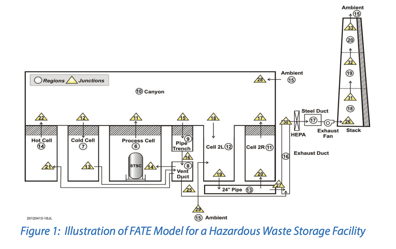
FATE is a practical modeling tool which captures the essential physics without resorting to detailed energy intensive CFD (Computational Fluid Dynamics) techniques. Thus, FATE is amenable to modeling highly compartmentalized facilities without being computationally expensive. FATE provides significant technical advantages over other lumped-parameter codes by using embedded (sub-nodal) distributed-parameter models. For example, FATE uses a two-layer model to track gas stratification in individual nodes. This allows the code to predict plume formation and stratification within rooms and thereby determine the composition of flow between rooms, including paths through doors, windows, stairwells, and ventilation systems (either active or disabled). Other examples of departure from the lumped-parameter approach include tracking of aerosol sized distributions and prediction of local aerosol sources.
Facility Fire and Environmental Release
A fire accident with sustained energy and aerosol release involves many physical phenomena that affect the transport of combustion products and other hazardous material throughout the facility and to the environment. Fire modeling must accommodate diverse room sizes and ventilation designs (both active and passive) along with the sometimes-uncertain configuration of doors and other leakage/ventilation paths. It can be readily demonstrated with FATE that something as simple as whether a door is open or closed can significantly affect the progression of an accident. Similarly, the buildup of particulate on a filter element can be shown to increase the associated pressure drop and degrade the performance of a ventilation system.
Soot is the dominant aerosol component during a fire and any associated contamination will tend to co-agglomerate with soot particles. Aerosols can be deposited on surfaces by thermophoresis and gravitational settling. The transport and distribution of soot and associated chemical (or radioactive or biological) contamination is thus of critical importance when doing a fire analysis of facilities which handle or process potentially toxic material.
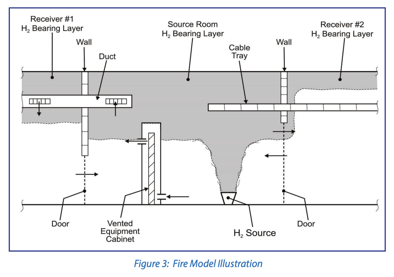 It is not straightforward to predict a priori the bounding configurations and scenarios during a facility fire, especially when considering the system response to changing environmental factors such as room temperature, pressure differences, and soot loading on ventilation filters. In short, the facility configuration can significantly impact the environmental release, so a flexible and fast running code like FATE is ideal for efficiently identifying the worst-case scenario(s).
It is not straightforward to predict a priori the bounding configurations and scenarios during a facility fire, especially when considering the system response to changing environmental factors such as room temperature, pressure differences, and soot loading on ventilation filters. In short, the facility configuration can significantly impact the environmental release, so a flexible and fast running code like FATE is ideal for efficiently identifying the worst-case scenario(s).
Figure 3 illustrates some of the FATE fire model features. Although the figure shows essentially a single room, FATE can handle hundreds of rooms and flow paths to represent a large facility. In FATE, all control volumes can be stratified regions whose upper layer (typically called the smoky layer in fire analysis) has a different composition, energy and temperature than that of the lower layer. Flow between regions is dictated by the relative positions of the flow opening and evolving layer heights.
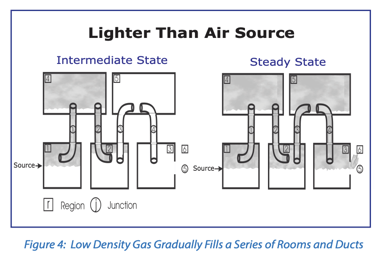 Layers might mix within a region, say due to a density inversion or plume entrainment. Aerosols can form and settle from either layer onto cold surfaces, or even settle from the upper layer to the lower layer.
Layers might mix within a region, say due to a density inversion or plume entrainment. Aerosols can form and settle from either layer onto cold surfaces, or even settle from the upper layer to the lower layer.
In FATE, the building ventilation headers and exhaust stack are treated as control volumes. The ventilation system may be operating (active) or disabled (static). Figure 4 shows a simple network of rooms connected by ducts, with a low-density source that stratifies on the top of the region volumes. The analogous situation of a high density (heavier than air) source could be similarly modeled. FATE predictions are an efficient means for positioning monitoring and control instruments and for accident response planning.
Dust and Entrained Contamination
Contamination release in explosion scenarios is often by entrainment of deposited material. Liquid pools or films can be atomized, and deposited powders can become airborne given sufficient gas flow during venting of burned gases.
FATE not only allows combustion of gases, vapors and dusts, but also includes models for the entrainment of contamination and deposition of dust. FATE calculates local velocity fields and keeps track of the deposited or entrained mass. Separate entrainment models are included for the cases of powders, liquids, and yield-stress (Bingham) fluids because of differences in the underlying physics.
As aerosol contamination is transported from its point of entrainment to the environment, particles will coagulate and be deposited by various mechanisms. Coagulation and deposition depend on the particle size distribution. FATE employs a peer-reviewed approach using correlations to the exact solution of the aerosol equations for the limiting cases of an aerosol in equilibrium with its source and with decay by sedimentation. This correlation approach compares very well with experimental data commonly used to validate aerosol models.
The boundary conditions for flow and ventilation have a huge impact on the ability of contamination to be retained or released. Continued exhaust from unaffected process rooms can be beneficial, but this needs to be critically examined if the initial explosion leads to a secondary fire toward which air might be drawn from an unaffected process room. FATE calculations clearly demonstrate that the correct response to a fire or explosion in a process area is to maintain isolation of hallways and, if possible, to activate a filtered exhaust system. The worst case can be to allow fire doors to be opened, which allows through flow of air for secondary fires and contamination release.
Flammable Gas Accumulation
The accident at Fukushima clearly demonstrated the need to evaluate the potential for, and consequences of, flammable gas release, and in particular for hydrogen. FATE uses validated models which satisfy key requirements for hydrogen distribution analysis: plume formation by rising low-density flammable gas mixtures, stratification of such mixtures, density driven counter-current gas flow, building and HVAC system details and heat transfer and condensation effects.
Figure 5 shows a simplified illustration of FATE calculations for a hydrogen bearing gas mixture as it propagates through a building. Cross flow distribution (5a) depends on the countercurrent exchange flow of gases, as well as the geometry and resistance of connecting junctions. The buoyant hydrogen/air mixture accumulates (stratifies) near the ceiling of the source room, eventually growing in layer thickness to the point where it spills into adjacent rooms. This is similar in geometry to a hallway with a series of open doors. The evolution of vertical flow and plume formation (5b) can vary as the light gas layer grows to eventually include the gas source, shown here to be initially in the middle node (room). The rising plume entrains gas as it passes upward through multiple rooms. Eventually, the mixture may be vented to the environment, preferably in a controlled manner with filters or scrubbers. The evolving concentration of hydrogen in each room guides design and placement of ventilation ducts and hydrogen monitoring and control systems, such as igniters and recombiners, to keep hydrogen below flammable limits during and after the source event.
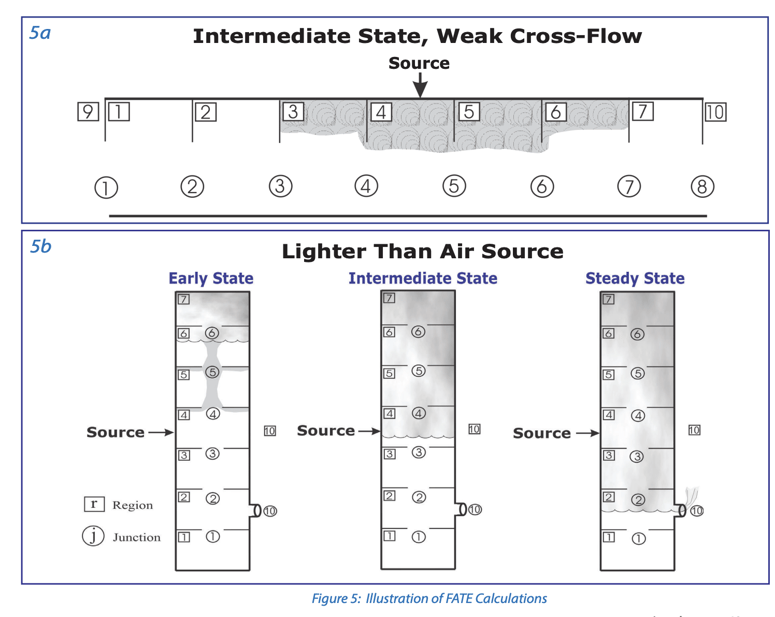
Summary
FATE is an integral facility and process model that considers layer stratification, plume behavior, and density-driven counter-current flow, along with aerosol formation, transport, and deposition. FATE is effective at modeling a complex facility with many rooms because it includes practical models for fire and explosion, along with inter-compartmental flows that account for density driven exchange and fully coupled engineered systems. These features are essential to comprehensive safety analysis of a facility which might experience fires or dust explosions or flammable gas accumulation, and especially where consequences of offsite release would be severe.
